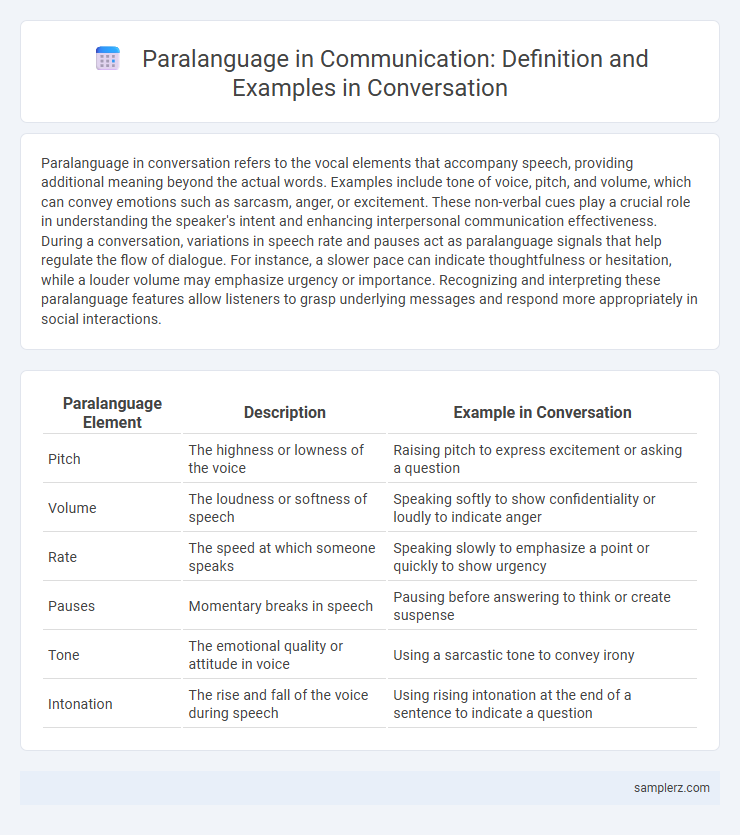Paralanguage in conversation refers to the vocal elements that accompany speech, providing additional meaning beyond the actual words. Examples include tone of voice, pitch, and volume, which can convey emotions such as sarcasm, anger, or excitement. These non-verbal cues play a crucial role in understanding the speaker's intent and enhancing interpersonal communication effectiveness. During a conversation, variations in speech rate and pauses act as paralanguage signals that help regulate the flow of dialogue. For instance, a slower pace can indicate thoughtfulness or hesitation, while a louder volume may emphasize urgency or importance. Recognizing and interpreting these paralanguage features allow listeners to grasp underlying messages and respond more appropriately in social interactions.
Table of Comparison
| Paralanguage Element | Description | Example in Conversation |
|---|---|---|
| Pitch | The highness or lowness of the voice | Raising pitch to express excitement or asking a question |
| Volume | The loudness or softness of speech | Speaking softly to show confidentiality or loudly to indicate anger |
| Rate | The speed at which someone speaks | Speaking slowly to emphasize a point or quickly to show urgency |
| Pauses | Momentary breaks in speech | Pausing before answering to think or create suspense |
| Tone | The emotional quality or attitude in voice | Using a sarcastic tone to convey irony |
| Intonation | The rise and fall of the voice during speech | Using rising intonation at the end of a sentence to indicate a question |
Understanding Paralanguage in Communication
Paralanguage in communication includes vocal elements like tone, pitch, volume, and speech rate that convey meaning beyond words. For example, a rising intonation can indicate a question or uncertainty, while a slow, deliberate speech pace may express seriousness or emphasis. Understanding these vocal cues enhances message interpretation and improves interpersonal communication effectiveness.
Key Elements of Paralanguage
Paralanguage elements such as tone of voice, pitch, and speech rate play crucial roles in conveying emotions and emphasis during conversation. Variations in volume can indicate confidence or hesitation, while pauses often signal thoughtfulness or uncertainty. These non-verbal cues enhance the meaning of spoken words and facilitate clearer interpersonal communication.
Tone of Voice: Conveying Emotion and Intention
Tone of voice plays a crucial role in conveying emotion and intention during conversations by modulating pitch, volume, and pace to express feelings such as anger, sarcasm, or sincerity. For example, a higher pitch and faster pace can indicate excitement, while a lower pitch and slower tempo often communicate seriousness or empathy. These vocal nuances enhance the clarity of the message and help listeners interpret the speaker's true emotions beyond the literal meaning of words.
Volume Control: Making an Impact
Volume control in conversation significantly influences message perception by emphasizing key points and conveying emotions such as urgency or calmness. Raising volume can indicate excitement or assertiveness, while lowering it may suggest intimacy or confidentiality. Effective modulation of voice volume enhances listener engagement and reinforces the speaker's intent.
Speech Rate: Indicating Urgency or Calm
A rapid speech rate often signals urgency or excitement, prompting listeners to pay immediate attention. Conversely, a slow, deliberate pace can convey calmness, thoughtfulness, or seriousness, allowing the message to resonate more deeply. Variations in speech rate serve as critical paralanguage cues that shape conversational tone and influence listener perception.
Pauses and Silence: Creating Meaning
Pauses and silence in conversation serve as powerful paralanguage elements that convey meaning beyond words. Strategic pauses can emphasize key points, regulate the flow of dialogue, and signal hesitation or contemplation. Silence often functions as a communicative tool, indicating agreement, discomfort, or prompting others to respond, thereby enriching interpersonal communication dynamics.
Pitch Variation: Adding Nuance to Words
Pitch variation in conversation significantly enhances meaning by conveying emotions and attitudes beyond the literal words spoken. A rising pitch can indicate a question or uncertainty, while a falling pitch often signals confidence or finality, allowing listeners to interpret the speaker's intent more accurately. Variations in pitch emphasize key points and add nuance, making communication more engaging and effective.
Laughter and Sighs: Nonverbal Cues in Speech
Laughter and sighs serve as powerful paralanguage elements, conveying emotions such as amusement, relief, or frustration beyond spoken words. These nonverbal cues enhance message clarity by signaling the speaker's true feelings and intentions, impacting conversational tone and listener interpretation. In communication studies, laughter often indicates social bonding, while sighs can express resignation or emphasis, making them essential tools for effective interpersonal interaction.
Intonation Patterns in Everyday Conversation
Intonation patterns in everyday conversation reveal speakers' emotions and intentions through variations in pitch, tone, and stress. Rising intonation often signals questions or uncertainty, while falling intonation conveys confidence and finality. These paralanguage cues enhance understanding beyond the literal meaning of words, improving interpersonal communication effectiveness.
Cultural Differences in Paralanguage Usage
Paralanguage varies significantly across cultures, influencing how messages are interpreted beyond words. For example, during conversations, tone of voice in Japanese culture is typically soft and subdued, signaling politeness and respect, while in Mediterranean cultures, a louder and more expressive tone conveys enthusiasm and engagement. Understanding these cultural differences in paralanguage is essential for effective communication and avoiding misunderstandings.

example of paralanguage in conversation Infographic
 samplerz.com
samplerz.com